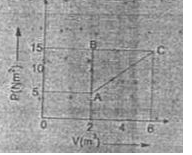An insulated vessel contains 1mole of a liquid, molar volume 100mL at 1bar. When liquid is steeply passed to 100bar, volume decreases to 99mL. Find ΔH and ΔU for the process.
From first law of thermodynamics:
ΔU=q+w
ΔU=q+PΔU=0+{−100(99−100)}
=100 bar mL
ΔH=ΔU+(P2V2−P1V1)
=100+(100×99−1×100)
=9900 bar mL.
Topper's Solved these Questions
- BOOK - OP TANDONCHAPTER - Chemical Thermodynamics and ThermochemistryEXERCISE - Practice problems81videos
Chemical Thermodynamics and Thermochemistry
- BOOK - OP TANDONCHAPTER - Chemical Thermodynamics and ThermochemistryEXERCISE - Objective Question Level-A177videos
Chemical Thermodynamics and Thermochemistry
- BOOK - OP TANDONCHAPTER - Chemical Thermodynamics and ThermochemistryEXERCISE - Illustrations of Objective Questions58videos
Chemical Thermodynamics and Thermochemistry
- BOOK - OP TANDONCHAPTER - CHEMICAL KINETICSEXERCISE - LINKED COMPRESHENSION TYPE QUESTIONS ( SECTION-VI)4videos
CHEMICAL KINETICS
- BOOK - OP TANDONCHAPTER - CLASSIFICATION AND NOMENCLATURE OF ORGANIC COMPOUNDS EXERCISE - INTEGER2videos
CLASSIFICATION AND NOMENCLATURE OF ORGANIC COMPOUNDS
Similar Questions
An insulated contains 1mole of a liquid, molar volume 100mL at 1bar. When liquid is steeply passed to 100bar, volume decreases to 99mL. Find ΔH and ΔU for the process.
View SolutionAn insulated vessel contains 1mole of a liquid, molar volume 100mL at 1bar. When liquid is steeply passed to 100bar, volume decreases to 99mL. Find ΔH and ΔU for the process.
View Solution
Knowledge Check
- Question 1 - Select One
In an insulated container 1 mole of a liquid. Molar volume 100 ml at 1 bar. Liquid is steeply taken to 100 bar, when volume of liquid decreases by 1 ml. Find ΔH for the process.
A7900 bar mlB8900 bar mlC9900 bar mlD10900 bar ml - Question 2 - Select One
There is 1 mol liquid (molar volume 100 ml) in an adiabatic container initial, pressure being 1 bar. Now the pressure is steeply increased to 100 bar ,and the volume decreased by 1 mL under constant pressure of 100 bar. Calculate ΔHandΔE.
[Given 1 bar = 105N/m2]AΔE=0J,ΔH≠0JBΔH=990J,ΔE=10JCΔE=20J,ΔH=890JDΔE=0J,ΔH=10J
The given figure shows a change of state A to state C by two paths. ABC and AC for an ideal gas. Calculate the ,

(a) Path along which work done is least.
(b) Internal energy at C if the internal energy of gas at A is 10 J and amount of heat supplied to change its state to C through the path AC is 200 J.
( c) Amount of heat supplied to the gas to gd from A to B, if internal energy of gas at state B is 10 J.
(ii) In an insulated contained 1 mole of a liquid, molar volume 100 mL. is at 1 bar liquid is steeply taken to 100 bar, where volume of liquid decreases by 1 mL. Find ΔE and ΔH for the process?
(iii) 14 g of oxygen at 0∘ C and 10 atm are subjected to reversible adiabatic expansion to a pressure of 1 atm. Calculate the work done in
(i) Litre atm.
(ii) Calorie (Given, CpCv=1.4).View Solution100mL of a liquid is contained in an insulated container at a pressure of 1bar. The pressure is steeply increased to 100bar. The volume of the liquid is decreased by 1mL at this constant pressure. Find ΔH and ΔU.
View SolutionThere is 1mol liquid (molar volume 100ml) in an adiabatic container initial, pressure being 1 bar Now the pressure is steeply increased to 100 bar, and the volume decreased by 1ml under constant pressure of 100 bar. Calculate ΔH and ΔE. [Given 1bar=105N/m2]
View Solution1 cf at liquid of molar volume 100 mL is kept in an adiabatic container under a pressure of 1 bar.The pressure is steeply increased to 100 bar.Under this constant pressure of 100 bar, the volume of the liquid decreases by 1 mL.Calculate ΔU of the process.
View SolutionThere is 1mol liquid (molar volume 100ml) in an adiabatic container initial, pressure being 1 bar Now the pressure is steeply increased to 100 bar, and the volume decreased by 1ml under constant pressure of 100 bar. Calculate ΔH and ΔE. [Given 1bar=105N/m2]
View SolutionPressure over 1000 ml of a liquid is gradually increases from 1 bar to 1001 bar under adiabitic conditions. If the final volume of the liquid is 990 ml, calculate ΔU and ΔH of the process, assuming linear variation of volume with pressure .
View Solution

